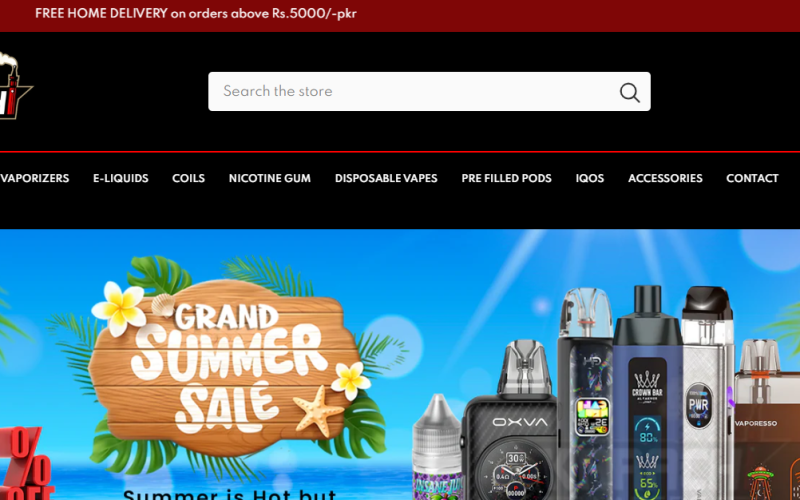Introduction
In the last decade, a technological innovation has quietly but powerfully reshaped how people around the world think about smoking and nicotine consumption. This innovation is none other than the vape—a sleek, battery-powered device that delivers nicotine or flavored vapor without the combustion found in traditional tobacco products.
From its humble beginnings as a cessation aid for smokers, the vape has evolved into a cultural symbol, lifestyle choice, and booming industry. In this blog, we explore the origin, growth, health implications, and cultural relevance of vaping, particularly among youth and ex-smokers. Whether you are a curious newcomer or a seasoned cloud chaser, this article will guide you through the ever-expanding world of vaping.
What Is a Vape?
A vape, or vaporizer, is a device that heats a liquid (commonly known as e-liquid or vape juice) to produce an aerosol, which the user then inhales. Unlike traditional cigarettes, which burn tobacco to deliver nicotine, a vape works on the principle of vaporization, eliminating harmful byproducts such as tar and carbon monoxide.
The e-liquid used in vapes typically contains:
- Propylene glycol (PG)
- Vegetable glycerin (VG)
- Nicotine (optional)
- Flavorings (fruit, dessert, mint, tobacco, etc.)
There are various types of vape devices, including:
- Cig-a-likes: Small and simple, designed to mimic cigarettes
- Pod systems: Popular among beginners and casual users
- Box mods: Advanced vapes with customizable settings
- Disposable vapes: Pre-filled, pre-charged, and meant for one-time use
Each of these offers a different experience based on the user’s preferences, nicotine needs, and lifestyle.
The Global Rise of Vaping
The vaping industry has experienced exponential growth over the past decade. According to market research, the global vape market is projected to reach over USD 60 billion by 2025. This expansion is fueled by increasing awareness of the harmful effects of traditional tobacco smoking, as well as by shifting consumer preferences toward cleaner, more socially acceptable alternatives.
In many countries, vaping has emerged as a powerful smoking cessation tool, supported by health organizations such as Public Health England, which stated that vaping is 95% less harmful than smoking cigarettes.
Meanwhile, vape lounges, online vape communities, cloud-chasing competitions, and an ever-growing list of e-liquid brands have transformed vaping from a habit into a subculture.
Why People Choose to Vape
There are several reasons why millions have switched from cigarettes to vapes:
- Healthier Alternative: Vaping eliminates the combustion process, which means no smoke, ash, or tar — key contributors to lung disease and cancer.
- Wide Flavor Selection: Vapes offer thousands of flavors, ranging from classic tobacco to exotic fruits, desserts, and beverages. This makes vaping more enjoyable and customizable than traditional smoking.
- Controlled Nicotine Intake: Users can choose their nicotine strength, or even opt for nicotine-free e-liquids, allowing for gradual reduction in dependence.
- Convenience: Modern vapes are portable, easy to use, and don’t require matches, lighters, or ashtrays. Disposable vapes are especially popular for their no-fuss functionality.
- Less Social Stigma: Unlike cigarettes, vapes produce vapor instead of smoke, which tends to dissipate quickly and doesn’t cling to clothes or furniture.
Vape Culture: A New Era of Expression
Vaping is more than just a means to deliver nicotine—it has become a form of personal expression. Vape users often identify with certain styles, flavors, devices, and communities. Some key elements of vape culture include:
- Cloud Chasing: The art of producing massive vapor clouds, often using advanced mods and high-VG liquids
- Flavor Chasing: The pursuit of the best-tasting e-liquids, regardless of cloud size
- DIY E-liquid Mixing: Enthusiasts who blend their own vape juice for a unique experience
- Online Vape Communities: Forums, YouTube channels, and social media groups where users share tips, reviews, and experiences
The culture also extends to fashion, music, and even tattoos, with vapers often incorporating elements of the lifestyle into their personal identity.
Health Implications: The Debate Continues
While vaping is widely regarded as safer than smoking, it is not entirely risk-free. Here are the key health considerations:
1. What We Know
- Vapes do not produce carbon monoxide or tar
- Most toxic chemicals in cigarette smoke are absent or present at much lower levels in vapor
- Vaping has helped many smokers quit tobacco for good
2. What’s Uncertain
- Long-term effects are still being studied
- Nicotine is still addictive and can affect adolescent brain development
- Some unregulated products (especially black-market vapes) may pose significant health risks
Experts agree that vaping is safer for adult smokers than continuing to smoke. However, non-smokers and teenagers are advised to avoid vaping altogether.
The Regulatory Landscape
Governments around the world are scrambling to regulate the booming vape industry. While some countries like the UK have embraced vaping as a harm-reduction tool, others have imposed heavy restrictions or outright bans.
In many places:
- Sales to minors are prohibited
- E-liquid packaging must include warning labels
- Flavored vapes may be restricted
- Taxes on vape products are increasing
Users should stay informed about local laws and buy products only from licensed and reputable sources.
The Future of Vaping
The future of the vape industry looks promising, especially as technology improves and public health initiatives recognize its potential as a smoking cessation aid. Innovations to look forward to include:
- Smart vapes with app integration and puff monitoring
- Heat-not-burn hybrids
- Improved battery efficiency
- More natural, organic flavorings
- Sustainable and recyclable materials
As research continues, the global conversation around vaping is shifting from skepticism to cautious optimism.
Conclusion
The vape has become far more than a smoking alternative — it’s a cultural phenomenon, a billion-dollar industry, and a symbol of modern lifestyle choices. Whether you’re using it to quit cigarettes, enjoy new flavors, or simply explore a new social space, vaping offers an experience that is both personal and versatile.
However, like any tool, it should be used responsibly. Educate yourself, choose authentic products, and vape mindfully. The future of nicotine delivery is here — and it’s vaporized.












